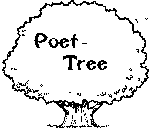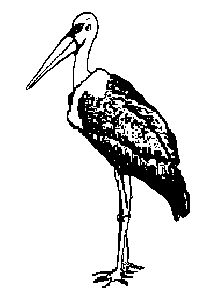 |
MARABOU: Newsletter April 1997 Vol. 3 No. 3 |
 |
-
* Thoughts in Solitude: Excerpt from: Sources et Vie Dominicaine
* Poet Tree: Silent Encounter. Sister Verona Weideg, O.P.
MARABOU is a quarterly newsletter for hermits and those interested in the eremitical life. This newsletter seeks to affirm this life style since it is ecclesially recognized and endorsed by the Church. MARABOU is to be a collaborative effort and thus depends on the reflections, poetry, news and information from hermits themselves.Subscribers to MARABOU are limited to those who are hermits and to those who aspire to the eremitical life. The circulation of MARABOU is limited, but if you feel you would qualify to be on our mailing list, kindly indicate your hermit status.
Important Announcement
After a time in prayer and discernment I have come to the decision to relinquish the editorship of Marabou. Fortunately, there is a seasoned hermit with considerable writing skills who is willing to pick up the reins. She is Karen Karper who has written expertly of the eremitical life and has published in journals. I am most grateful that she is willing to continue Marabou and we can look forward to her creativity and new style; she will bring to the newsletter. I would hope to take on a supportive role by offering news and submit arcicles from time to time. This April, 1997 issue will be my last and Karen will begin with the July, 1997 issue. Please address all correspondence, articles, and payment to:Karen Karper Box: 562 Hot Springs, NC 28743Many thanks to many of you who have contributed to Marabou over the past years. Having experienced the usefulness of such a newsletter. I feel confident you will continue with your support.Bede Jagoe, O.P.
River Forest, IL
The annual subscription fee is $7.50. MARABOU (ma-ra-bu) also marabout, marabu, (a. French marabou), app. repr. an Arabic use of murabit, hermit. The stork is said to be mrabt, i.e. hole (Pagni in Daozy, Suppl. aux Dictt. arabes, s.v. murabit.). Marabou, a large stork or heron, leptoptilius marabou, or crumnifer, a native of West Africa.
Thoughts in Solitude
Whether it was the absolute solitude of the extreme desert or the mitigated solitude of the desert near an inhabited world, the eremetical life at the time of Anthony and Pacomius knew the most diverse forms. It must be said that the ascetics who withdrew into the deserts of Egypt, Syria, or Palestine were pioneers in the subject. Their efforts were without precedent and it is for that reason that they were familiar with the most extravagant forms of asceticism. However, with the passage of time two great forms of eremetical life evolved: anchorism in the strict sense of those who would live alone according to the example of Saint Anthony (251-356), and the cenobitism of those who would come together in community under the direction of an abbot, in the form inaugurated by Saint Pacomius (287-347). The line of separation between these two forms of life is not very precise. They include a wide span which covers monastic life almost imperceptibly from one extreme to the other.The question was raised very early on about the respective significance of these two forms of life. It was agreed that the anchorite life presented greater dangers than the cenobitical life, in as much as the one who is solitary is much more given over to himself. It is for this reason that it is generally asked of those who wish to commit themselves to the anchorite life to experience the cenobitical life first, according to the rule of Saint Saba expressed by this beautiful image: as the flower precedes the fruit, thus does the cenobitical life precede the anchoritic. On the other hand, opinions differ on knowing which of the two forms of life is the highest. Many will accord primacy to the anchorite life. Others, like Saint Basil who does not hide his deep reservations about the anchorite life, prefer from a distance the cenobitical life.
In order to go beyond this rapid and partial glimpse, nothing is worth more in the reading of the great classics of eremetical literature but to begin with the life of Saint Anthony by Saint Athanasius. The life of Anthony helps us discover in the lively and concrete manner of a book of images the trials and difficulties of life in the desert, at the price of such stripping away and such struggles that the monk comes to the point finally of abandoning everything to the "one thing necessary."
After having passed through numerous trials and feeling himself abandoned by God to demonic powers, Anthony lets out this complaint to God who finally manifests himself: Where were you? Why did you not appear to me at the beginning to make my suffering cease? Then a voice responds to him: "I was there, Anthony, I was waiting to see you fight.:" Does this dialogue between Anthony and his God reveal to us, beyond the geographic desert of the monks, that spiritual desert, the interior place, through which every believer, wherever he finds himself, must pass in one way or another in order to take part fully in the happiness that God promises, that place of stark combat, but also that place of nuptials?
(An edition of the life of Anthony has just appeared in the collection of Sources Chrétiennes.)
Excerpt from: Sources et Vie Dominicaine. Translated by Sr. Mary Ellen Green, O.P., No. 4, XXII.
Silent EncounterVaulted, blue sky,Woods encircling lofty trees Create nature's secluded, enclosed cathedral Beyond the solitary's hermitage picture window.
Sunlight rays ebb in, out now here, now there
Overcast sky,
Cathedral's unadorned sanctuary: Sister Verona Weideg, O.P. |

|